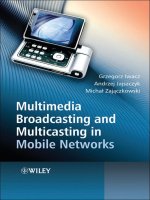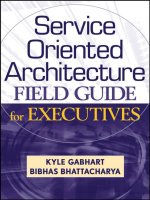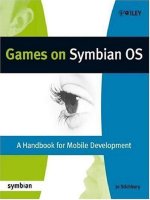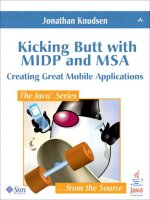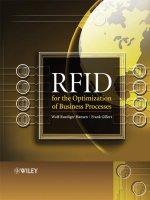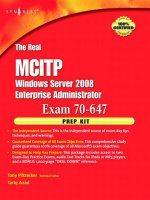Wiley the open mobile alliance delivering service enablers for next generation applications apr 2008 ISBN 0470519185 pdf
Bạn đang xem bản rút gọn của tài liệu. Xem và tải ngay bản đầy đủ của tài liệu tại đây (6.06 MB, 532 trang )
The Open Mobile Alliance
The Open Mobile Alliance
Delivering Service Enablers for
Next-Generation Applications
Michael Brenner, Alcatel-Lucent, USA
Musa Unmehopa, Alcatel-Lucent, The Netherlands
Copyright 2008
Alcatel-Lucent. All Rights Reserved.
Published by
John Wiley & Sons Ltd, The Atrium, Southern Gate, Chichester,
West Sussex PO19 8SQ, England
Telephone (+44) 1243 779777
Email (for orders and customer service enquiries):
Visit our Home Page on www.wileyeurope.com or www.wiley.com
All Rights Reserved. No part of this publication may be reproduced, stored in a retrieval system or transmitted in any
form or by any means, electronic, mechanical, photocopying, recording, scanning or otherwise, except under the terms
of the Copyright, Designs and Patents Act 1988 or under the terms of a licence issued by the Copyright Licensing
Agency Ltd, 90 Tottenham Court Road, London W1T 4LP, UK, without the permission in writing of the Publisher.
Requests to the Publisher should be addressed to the Permissions Department, John Wiley & Sons Ltd, The Atrium,
Southern Gate, Chichester, West Sussex PO19 8SQ, England, or emailed to , or faxed to (+44)
1243 770620.
Designations used by companies to distinguish their products are often claimed as trademarks. All brand names and
product names used in this book are trade names, service marks, trademarks or registered trademarks of their respective
owners. The Publisher is not associated with any product or vendor mentioned in this book. All trademarks referred
to in the text of this publication are the property of their respective owners.
This publication is designed to provide accurate and authoritative information in regard to the subject matter covered.
It is sold on the understanding that the Publisher is not engaged in rendering professional services. If professional
advice or other expert assistance is required, the services of a competent professional should be sought.
Other Wiley Editorial Offices
John Wiley & Sons Inc., 111 River Street, Hoboken, NJ 07030, USA
Jossey-Bass, 989 Market Street, San Francisco, CA 94103-1741, USA
Wiley-VCH Verlag GmbH, Boschstr. 12, D-69469 Weinheim, Germany
John Wiley & Sons Australia Ltd, 42 McDougall Street, Milton, Queensland 4064, Australia
John Wiley & Sons (Asia) Pte Ltd, 2 Clementi Loop #02-01, Jin Xing Distripark, Singapore 129809
John Wiley & Sons Canada Ltd, 6045 Freemont Blvd, Mississauga, Ontario, L5R 4J3, Canada
Wiley also publishes its books in a variety of electronic formats. Some content that appears
in print may not be available in electronic books.
Library of Congress Cataloging-in-Publication Data
Unmehopa, Musa.
The open mobile alliance : delivering service enablers for nextgeneration applications / Michael Brenner, Musa Unmehopa
p. cm.
Includes index.
ISBN 978-0-470-51918-9 (cloth)
1. Mobile communication systems. I. Brenner, Michael. II. Title.
TK6570.M6U55 2008
621.384 – dc22
2007042810
British Library Cataloguing in Publication Data
A catalogue record for this book is available from the British Library
ISBN 978-0-470-51918-9 (HB)
Typeset in 9/11 Times by Laserwords Private Limited, Chennai, India
Printed and bound in Great Britain by Antony Rowe Ltd, Chippenham, England
This book is printed on acid-free paper responsibly manufactured from sustainable forestry
in which at least two trees are planted for each one used for paper production.
Trademarks and Permissions
America Online and AOL are trademarks of AOL LLC.
BlackBerry is a trademark of Research In Motion Limited.
CableLabs and PacketCable are trademarks of Cable Television Laboratories, Inc.
cdma2000 is a registered trademark of the Telecommunications Industry Association (TIA-USA)
in the United States.
CORBA and OMG are trademarks or registered trademarks of Object Management Group, Inc.
in the United States and/or other countries.
DVB is a registered trademark of the DVB Project.
eTOM is a registered trademark of the TM Forum.
Google is a trademark of Google Inc.
iPod and iTunes are trademarks of Apple Inc., registered in the U.S. and other countries.
Java, J2EE, J2ME, J2SE, and Sun are trademarks of SUN Microsystems, Inc. in the
United States and other countries.
Microsoft, Outlook and Windows Media Player are either registered trademarks or trademarks
of Microsoft Corporation in the United States and/or other countries.
NEXTEL is a trademark of Sprint Nextel.
OASIS and SAML are trademarks of OASIS (Organization for the Advancement of Structured
Information Standards).
UMTS and 3GPP are registered trademarks of ETSI in France and other jurisdictions.
W3C is a registered trademark of the World Wide Web Consortium, registered in numerous
countries.
WiMAX is a trademark of the WiMAX Forum.
Yahoo is a registered trademark of Yahoo, Inc.
WiFi is a registered trademark of the Wi-Fi Alliance.
3GPP(tm) TSs and TRs are the property of ARIB, ATIS, ETSI, CCSA, TTA and TTC who jointly
own the copyright in them. They are subject to modifications and are therefore provided to you “as
is” for information purposes only. Further use is strictly prohibited.
To Hedy – who challenged me to start the book, and Greta, Dan and Andrew – who challenged
me to finish it. MB
To Odette and Aron, of course. MU
Contents
Trademarks and Permissions
v
Dedication
vii
Foreword
xxi
Preface
I. Who Should Read This Book?
II. What to Cover?
III. A Word on Timing
IV. A Disclaimer
xxiii
xxiv
xxiv
xxiv
xxv
Acknowledgements
xxvii
About the Authors
xxix
List of Figures
Part I
1
2
Background and Introduction
xxxiii
1
Introduction
3
1.1
1.2
1.3
3
4
5
Service Enablers
The Open Mobile Alliance (OMA)
Service Enablers in OMA
The Silo Syndrome and its Solution
2.1
2.2
2.3
2.4
2.5
2.6
Vertical Integration
Re-use as First-Class Citizen
2.2.1
Service Enablers
2.2.2
Interfaces
2.2.3
Some Examples Using Interfaces
2.2.4
Resources
The OSE
2.3.1
Policy Enforcer
2.3.2
OSE Interface Categories
2.3.3
Protocol Bindings
2.3.4
Putting the Piece Parts Together
2.3.5
What the OSE Isn’t
Additional Features of the OSE
2.4.1
Protection of Resources
2.4.2
End-user Experience
OSE and Related Technologies
Summary
7
7
9
10
11
12
13
13
14
15
17
17
18
18
18
18
19
19
x
3
Contents
The Open Mobile Alliance – An Organizational Overview
21
3.1
21
22
23
23
24
25
25
26
27
28
33
33
33
34
34
34
34
35
36
37
39
40
3.2
3.3
3.4
3.5
3.6
3.7
4
5
6
Interoperability TestFests
41
4.1
4.2
4.3
4.4
4.5
4.6
4.7
41
42
43
44
44
44
45
The Objective of Interoperability in the OMA
The Organization of the Test Campaigns
Planning
Finances
TestFest Statistics
Comparison with Other Standards Development Organizations (SDOs)
Summary
Service Provider – The Network Operator Perspective
47
5.1
5.2
5.3
5.4
47
50
53
55
The Need for OMA
Operators in the OMA
OMA Challenges for the Future
Summary
Service Provider – The Enterprise Perspective
57
6.1
6.2
6.3
57
59
60
Part II
7
Overview of the OMA
3.1.1
Affiliation – A Historic Perspective
Principles of the OMA
The OMA’s Relationship with External Organizations
OMA Organizational Structure
3.4.1
OMA Board of Directors
3.4.2
Technical Plenary
3.4.3
OMA Committees
3.4.4
OMA Horizontal Working Groups
3.4.5
OMA Vertical Working Groups
3.4.6
OMA Birds of a Feather Groups
The Processes
3.5.1
Smooth Sailing, no Waterfalls or Gates
3.5.2
Support for Off-line Progress and Decision Making
3.5.3
Strive for Consensus
3.5.4
Low Threshold for New Work
3.5.5
Enabler Release Program
Interoperability in the Open Mobile Alliance
3.6.1
The Objectives of the OMA IOP
3.6.2
Process and Documentation
3.6.3
OMA Interoperability Recognition Program
Summary
Enterprise Needs
OMA Enterprise Awareness
Summary
Horizontal Topics
61
The Policy Enforcer Details: Model, Architecture, Realization, and Impact
63
7.1
63
Policy Enforcement Modeling in the OSE
Contents
7.2
7.3
7.4
7.5
7.6
7.7
7.8
7.9
8
Beyond the OSE: Policy Enforcement as Service Oriented Architecture
Composition
Logical Architecture versus Deployment Considerations
Relationship to Parlay and IP Multimedia Subsystem (IMS)
Policy Modeling
Policy Enforcer through OMA Enabler Realization
Relationship of Policy Enforcer to IETF PEP/PDP
Policy Assembly, Composition, and Orchestration
7.8.1
Model and PEL Assembly
7.8.2
Usage Considerations
7.8.3
Policies in Service Provider Domain
Summary – Next Steps
The Policy Evaluation, Enforcement, and Management Enabler
8.1
8.2
8.3
8.4
8.5
8.6
8.7
9
xi
Are Those Specifications Really Needed?
8.1.1
Policy Control and Management Overview
8.1.2
Standards Precursors to PEEM
8.1.3
What Roles Are the PEEM Specifications Playing?
PEEM Market Needs
8.2.1
Use Case for Explicit Requests to PEEM
8.2.2
Use Case for Intercepted Requests by PEEM
8.2.3
PEEM Requirements
PEEM Architecture and Technical Specifications
8.3.1
PEEM in the OSE
8.3.2
PEEM Logical Architecture
8.3.3
Logical Flows for PEEM
8.3.4
PEEM Policy Expression Language Details
8.3.5
PEM-1 Interface Details
8.3.6
PEM-2 Interface Specification
PEEM Salient Points
8.4.1
Usage Patterns
8.4.2
Expert Topics for PEL
8.4.3
Expert Topics for PEM-1
8.4.4
Divergent Views and their Resolution
Impact of Specifications on the Industry
8.5.1
Impact on Service Providers
8.5.2
Impact on Vendors
8.5.3
Impact on Consumer Market
8.5.4
Impact on Corporate Market
8.5.5
Impact on Other Specifications
Specifications Evolution and Future Direction
Summary
65
68
68
69
69
71
71
71
72
73
75
77
78
79
80
82
82
83
84
86
89
89
90
93
94
96
98
99
99
103
104
105
107
108
109
110
111
112
112
113
Utilization of IMS in OMA
115
9.1
9.2
9.3
9.4
9.5
116
117
117
120
122
Are Those Specifications Really Needed?
Standard Precursors to IMSinOMA
Architecture Overview
Salient Points and Divergent Views
Impact of Specifications
xii
Contents
9.6
9.7
10
122
122
123
123
Service Architectures – Parlay and the OSE
125
10.1
125
126
128
129
129
130
130
131
131
132
133
133
133
10.2
10.3
10.4
10.5
10.6
11
9.5.1
Impact on the Industry
9.5.2
Impact on Other Specifications
Specifications Evolution and Future Direction
Summary
A Quick Taster of Parlay
10.1.1 Parlay X
The Parlay in OSE Enabler
10.2.1 Parlay as Network Resource
10.2.2 Parlay X Web Service as the Enabler
10.2.3 Parlay Service Capability Feature as the Enabler
10.2.4 Hybrid Parlay and OMA Solution
PIOSE Challenges
10.3.1 Enforcing Service Provider Policies
10.3.2 The Parlay Policy Management Service Capability Feature
Impact of Specifications on the Industry
Specifications Evolution and Future Direction
Summary
A Web Services Technology Realization of the OSE
135
11.1
11.2
11.3
136
137
139
139
139
140
140
142
142
143
144
145
145
146
146
146
148
149
149
150
150
150
150
151
151
151
11.4
11.5
11.6
Web Services Crash Course
A Web Services Infrastructure Framework
Mobile Web Services
11.3.1 The Mobile Network as Content Source for the Web Service
11.3.2 The Mobile Device as Web Service Requestor
11.3.3 The Mobile Device as Web Service Provider
The OMA Web Services Enabler Release
The Technologies Specified by OWSER
11.5.1 Transport
11.5.2 Messaging
11.5.3 Description
11.5.4 Quality of Service
11.5.5 Components
11.5.6 Discovery
Network Identity
11.6.1 Identity Management Concepts Overview
11.6.2 Identity Provider Introduction
11.6.3 Identity Federation and Single Sign-On
11.6.4 Name Registration
11.6.5 Authentication Context
11.6.6 Single Sign-Out
11.6.7 Federation Termination Notification
11.6.8 Attribute Query and/or Modification
11.6.9 Usage Directive
11.6.10 Interaction Service
11.6.11 Bootstrapping Identity based Web Services Framework
Contents
12
11.6.12 Discovery Service
11.6.13 Liberty enabled User Agent
11.6.14 Security
11.6.15 Network Identity Conclusions
11.7 OWSER and the OSE
11.8 Divergent Views and their Resolution
11.9 Specifications Evolution and Future Direction
11.9.1 Web Services on Devices
11.9.2 XML Usage Guide
11.9.3 Common XML Dictionary
11.9.4 Additional WS-I Profiles
11.9.5 Other Industry Profiles
11.10 Impact of the Specifications
11.10.1 Impact on the Industry
11.10.2 Impact on Other Specifications
11.11 Summary
151
152
152
152
153
154
154
155
155
155
155
156
157
157
157
157
The OMA Service Provider Environment Enabler
159
12.1
12.2
12.3
12.4
160
161
163
164
164
165
167
167
168
169
172
173
174
174
174
175
175
175
175
12.5
12.6
12.7
12.8
12.9
13
xiii
Are Those Specifications Really Needed?
OSPE Use Cases
OSPE Requirements
Standard Precursors to OSPE
12.4.1 OAM&P Standards in the Telecommunications Industry
12.4.2 OAM&P Standards in the IT Industry
OSPE Architecture and Technical Specifications
12.5.1 OSPE Enabler in the OSE
12.5.2 OSPE Logical Architecture
12.5.3 OSPE Logical Flows
OSPE Salient Points
Impact of Specifications on the Industry
12.7.1 Impact on Service Providers
12.7.2 Impact on Vendors
12.7.3 Impact on Consumer Market
12.7.4 Impact on Corporate Market
12.7.5 Impact on Other Specifications
Specifications Evolution and Future Direction
Summary
The Security Enablers
177
13.1
179
180
180
180
180
180
181
182
13.2
Are Those Specifications Really Needed?
13.1.1 Wireless Public Key Infrastructure
13.1.2 On-board Key Generation (OBKG)
13.1.3 Online Certificate Status Protocol Mobile Profile
13.1.4 Smart Card Web Server (SCWS)
Security Common Functions Enabler
13.2.1 SEC-CF Use Case
13.2.2 Security Common Functions Requirements
xiv
Contents
13.3
13.4
13.5
13.6
13.2.3 Standards Precursors to Security Common Functions
13.2.4 SEC-CF Architecture and Technical Specifications
13.2.5 SEC-CF Technical Specifications
SEC-CF Salient Points
13.3.1 Divergent Views and their Resolution
Impact of Specifications on the Industry
13.4.1 Impact on Service Providers
13.4.2 Impact on Vendors
13.4.3 Impact on Consumer Market
13.4.4 Impact on Corporate Market
13.4.5 Impact on Other Specifications
Specifications Evolution and Future Direction
Summary
182
182
186
188
189
189
190
190
191
191
191
192
192
Part III Selected OMA Service Enablers
193
14
The Presence and List Management Enablers
195
14.1
14.2
195
196
196
197
198
199
199
200
200
201
202
202
203
204
205
205
205
207
209
14.3
14.4
14.5
14.6
14.7
15
Presence – What is it?
A Constructionist View of Presence Architectures
14.2.1 Basic Elements
14.2.2 Presence Service Interfaces and the Resource List Server
14.2.3 Presence Authorization Policies
14.2.4 Presence-related Event Packages
14.2.5 Presence Optimizations
14.2.6 Presence Standards
14.2.7 The ‘Three-Layer Brick’ Model
14.2.8 The IETF Presence Model and Standards
14.2.9 A Summary of IETF Presence Standards
14.2.10 The 3GPP2 Presence Model and Standards
14.2.11 The 3GPP Presence Model and Standards
14.2.12 The OSA PAM SCF Model
The OMA Presence Model and Specifications
14.3.1 Presence, XDM, and IMPS Enablers in the OSE
14.3.2 Wireless Village and OMA Instant Messaging and Presence Service
14.3.3 OMA Presence SIMPLE
14.3.4 OMA XML Document Management
A Deployment Example – Deploying Presence and XDM Enablers in an IMS
or MMD environment
Impact of Specifications on the Industry
Specifications Evolution and Future Direction
Summary
213
215
215
215
The Push-to-talk over Cellular Enabler
217
15.1
15.2
15.3
218
218
219
219
227
233
15.4
Are Those Specifications Really Needed?
Standard Precursors to OMA Push-to-talk over Cellular
Architecture and Technical Specifications Overview
15.3.1 PoC V1.0 Architecture and Functional Description
15.3.2 Enhancements for PoC V2.0 in Architecture and Functionality
Salient Points
Contents
15.5
15.6
15.7
16
233
233
234
234
234
237
16.1
237
239
240
243
243
245
247
250
16.3
Background
16.1.1 Market Drivers
16.1.2 The Standards Landscape
MEM Architecture
16.2.1 Analysis
16.2.2 Data Synchronization (DS) Realization
16.2.3 LEMONADE Realization
Summary
The Charging Enabler
251
17.1
17.2
252
253
253
17.3
17.4
17.5
17.6
17.7
17.8
18
Impact of Specifications on the Industry
15.5.1 Impact on Service Providers, Vendors, Consumer, and Corporate
Market
15.5.2 Impact on Other Specifications
Specifications Evolution and Future Direction
Summary
Mobile E-mail
16.2
17
xv
Are Those Specifications Really Needed?
Standards Precursors to Charging
17.2.1 Mobile Commerce Four Party Model
17.2.2 Convergence of Financial, IT, and Telephony Aspects of the Charging
Enabler
17.2.3 Influence from Other Standards
Charging Requirements
Charging Architecture and Technical Specifications
17.4.1 The Charging Enabler in the OSE
17.4.2 Charging Logical Architecture
17.4.3 Charging Logical Flows
17.4.4 Charging Enabler Technical Specifications
Divergent Views and Their Resolution
Impact of Specifications on the Industry
17.6.1 Impact on Service Providers
17.6.2 Impact on Vendors
17.6.3 Impact on Other Specifications
Specifications Evolution and Future Direction
Summary
254
255
255
255
256
256
258
261
265
265
266
266
266
266
267
The Device Management Enablers
269
18.1
18.2
271
271
271
272
273
274
276
276
277
Device
Device
18.2.1
18.2.2
18.2.3
18.2.4
18.2.5
18.2.6
18.2.7
Management Requirements
Management Architecture
DM in the OMA Service Environment
Generic DM Architecture – Components and Interfaces
Initial Provisioning
OMA Device Management Architecture
Bootstrapping
The DM Protocol
The Management Tree
xvi
Contents
18.3
18.4
18.5
18.6
19
18.2.8 Management Commands
18.2.9 Client Responses and Alerts
18.2.10 Aggregate Management Operations
18.2.11 Configuration Data Storage Models
Device Management Enabler Specifications
18.3.1 History
18.3.2 OMA Client Provisioning
18.3.3 OMA Device Management
18.3.4 Domain-specific Device Management Enablers
Impact of DM Specifications on the Industry
18.4.1 Impact on Service Providers
18.4.2 Impact on Vendors
18.4.3 Impact on Consumer Market
18.4.4 Impact on Corporate Market
18.4.5 Impact on Other Specifications
Specifications Evolution and Future Direction
Summary
278
279
279
280
280
281
281
282
282
286
286
287
287
287
287
287
288
The Digital Rights Management Enabler
289
19.1
19.2
290
291
292
292
293
293
293
293
293
293
294
294
294
294
294
295
295
295
295
295
297
297
298
298
299
299
300
300
301
302
19.3
19.4
19.5
19.6
19.7
19.8
What Were the Drivers for Those Specifications?
Are Those Specifications Really Necessary?
19.2.1 Basic Download
19.2.2 Multiple Device Usage
19.2.3 Super-distribution (Peer-to-Peer Sharing)
19.2.4 Preview
19.2.5 Buying the Rights Object for another User
19.2.6 Streaming Content
19.2.7 Backup and Restore
19.2.8 Export of Rights Object
OMA DRM Requirements
19.3.1 Types of Content
19.3.2 Rights Objects
19.3.3 Content and Rights Object Delivery
19.3.4 Streaming
19.3.5 Enhanced Security
19.3.6 Export of Rights Object
19.3.7 Super-distribution
19.3.8 Backup and Storage
Architecture and Technical Specifications Overview
Salient Points
19.5.1 Divergent Views and Their Resolution
Impact of Specifications on the Industry
19.6.1 Impact on Service Providers
19.6.2 Impact on Vendors
19.6.3 Impact on Consumer Market
19.6.4 Impact on Corporate Market
19.6.5 Impact on other Specifications
Specifications Evolution and Future Direction
Summary
Contents
xvii
20
The Broadcast Enabler
303
20.1
20.2
20.3
304
305
306
307
308
319
320
320
20.4
20.5
20.6
21
The Dynamic Content Delivery Enabler
321
21.1
322
323
325
325
325
326
328
328
329
330
332
333
333
333
334
334
334
335
335
335
335
21.2
21.3
21.4
21.5
21.6
21.7
21.8
22
Are Those Specifications Really Needed?
Standards Precursors to BCAST Enabler
BCAST Architecture
20.3.1 BCAST Logical Architecture (Reference Points)
20.3.2 BCAST Enabler Functions and Interfaces
Impact of Specifications
Specifications Evolution and Future Direction
Summary
Why Do We Need New Specifications for DCD?
21.1.1 DCD Use Cases
Standards Precursors to DCD
DCD Architecture and Technical Specifications
21.3.1 DCD in the OMA Service Environment
21.3.2 DCD Logical Architecture
21.3.3 DCD Technical Specifications
DCD Deployment Options
21.4.1 A DCD Deployment Example
21.4.2 A DCD Service Example
DCD Salient Points
Impact of Specifications on the Industry
21.6.1 Impact on Service Providers
21.6.2 Impact on Content Providers
21.6.3 Impact on Application Developers
21.6.4 Impact on Vendors
21.6.5 Impact on Consumer Market
21.6.6 Impact on Corporate Market
21.6.7 Impact on Other Specifications
Specifications Evolution and Future Direction
Summary
The Global Permissions Management Enabler
337
22.1
338
339
340
342
342
343
343
344
346
347
347
349
349
349
349
22.2
22.3
22.4
22.5
Are Those Specifications Really Needed?
22.1.1 GPM Actors and Main Concepts in the Requirements Document
22.1.2 A Typical GPM Flow
22.1.3 Management of Permissions Rule
Standards Precursors to GPM
GPM Architecture and Technical Specifications
22.3.1 GPM in the OSE
22.3.2 GPM Logical Architecture
22.3.3 Logical Flows for GPM
22.3.4 GPM Technical Specifications
GPM Salient Points
Impact of Specifications on the Industry
22.5.1 Impact on Service Providers
22.5.2 Impact on Vendors
22.5.3 Impact on Consumer Market
xviii
Contents
22.6
22.7
23
351
23.1
23.2
23.3
354
356
356
357
358
362
364
364
364
365
365
365
365
366
366
23.5
23.6
Are Those Specifications Really Needed?
Standards Precursors to CBCS
CBCS Architecture and Technical Specifications
23.3.1 CBCS Enabler in the OSE
23.3.2 CBCS Logical Architecture
23.3.3 Logical Flows for CBCS
23.3.4 CBCS Technical Specifications
Impact of Specifications on the Industry
23.4.1 Impact on Service Providers
23.4.2 Impact on Vendors
23.4.3 Impact on Consumer Market
23.4.4 Impact on Corporate Market
23.4.5 Impact on Other Specifications
Specifications Evolution and Future Direction
Summary
The Game Services Enabler
367
24.1
24.2
24.3
368
369
369
370
371
372
375
376
376
377
377
377
379
24.4
24.5
24.6
25
350
350
350
350
The Categorization Based Content Screening Enabler
23.4
24
22.5.4 Impact on Corporate Market
22.5.5 Impact on Other Specifications
Specifications Evolution and Future Direction
Summary
Are Those Specifications Really Needed?
Standards Precursors to Game Services
Game Services Specifications
24.3.1 The Gaming Platform
24.3.2 Game Services Architecture
24.3.3 Game Services – Client/Server Interface Enabler
Impact of Specifications on the Industry
24.4.1 Impact on Service Providers
24.4.2 Impact on Vendors
24.4.3 Impact on Consumer Market
24.4.4 Impact on Other Specifications
Specifications Evolution and Future Direction
Summary
The Location Enabler
381
25.1
25.2
382
383
383
385
387
387
387
387
25.3
What is Location?
Location Architectures
25.2.1 Control Plane Location
25.2.2 User Plane Location
The Mobile Location Services Enabler
25.3.1 OMA Mobile Location Protocol
25.3.2 OMA Privacy Checking Protocol
25.3.3 OMA Roaming Location Protocol
Contents
25.4
25.5
26
The Secure User Plane Location
25.4.1 SUPL 1.0 Architecture
25.4.2 SUPL 2.0 Architecture
25.4.3 SUPL Technical Specifications
25.4.4 SUPL Sequence Flow
Summary
388
389
391
393
397
400
The Mobile Application Environment
401
26.1
26.2
402
403
403
403
405
405
406
406
407
407
409
26.3
26.4
26.5
27
xix
The Mobile Web Architecture
Mobile Browser
26.2.1 Precursors
26.2.2 OMA Extensions
Mobile Content Data Formats
26.3.1 vObject
26.3.2 SVG for the Mobile Domain
26.3.3 SMIL for the Mobile Domain
26.3.4 Where Browser and Content Meet
Multiple Interaction Modalities and Devices
Summary
Recent Topics
411
27.1
411
412
412
413
414
414
415
415
416
416
416
417
417
418
418
418
421
421
423
424
27.2
27.3
27.4
The General Service Subscription Management Enabler
27.1.1 Prior Work – Subscription Management
27.1.2 New Work – General Service Subscription Management
27.1.3 Related Activities
Device Profile Evolution
27.2.1 Prior Work – Static Properties
27.2.2 New Work – Dynamic Properties
27.2.3 DPE Examples
27.2.4 DPE Related Activities
Converged IP Messaging Enabler
27.3.1 Multimedia Messaging Service
27.3.2 Instant Messaging and Presence Service
27.3.3 SIP and IMS introduce SIMPLE Instant Messaging
27.3.4 Push-to-Talk over Cellular
27.3.5 OMA’s Approach to Enablers
27.3.6 Converged IP Messaging
27.3.7 CPM Summary
Mobile Advertising
27.4.1 Prior Work – Mobile Advertising Landscape
27.4.2 New Work – Mobile Advertising
Part IV Conclusions
427
28
Concluding Remarks, and What’s in Store Next?
429
28.1
28.2
429
430
Project Post-mortem
What’s Next?
xx
Contents
Annex A
435
Abbreviations and Acronyms
441
References
455
Index
469
Foreword
Communication, and the ability to interact in advanced and complex forms over great distances, is
mankind’s greatest differentiator with the other species. The ability to communicate has resulted
in mankind becoming the dominating species, enabling us to record the past, engage in the present
and prepare for the future.
With all our modern communication systems, it is difficult to imagine a world without the ability
to communicate. So dependent is today’s society on modern communications that a world without
radios, televisions, computers, PDAs, Internet, and telephones and mobile phones would set us
back hundreds of years and severely impact our ability to go about modern day life. The modern
means of communication that we take for granted are expected to continue driving forward and
further increase society’s dependence in the future. Developing future communication methods is
thus crucial to shaping the way we interact and evolve as a society.
The Open Mobile Alliance (OMA) resulted from the need to further evolve mobile communications. Early mobile communications in first generation analog mobile systems were superseded by
the 1980s move towards second generation digital mobile systems, incorporating some ISDN telephony services. Enhancements to the second generation digital mobile systems provided enhanced
data bandwidth and some additional services infrastructure. Development of third generation digital mobile systems began in the early 1990s to enable higher data rates for multimedia services.
However, much more was needed to enable and promote interoperable data services to fulfill the
multimedia expectations. It was this unsatisfied demand that resulted in the creation of OMA.
During late 2001 and early 2002, a grouping of companies (calling itself the Open Mobile
Architecture Initiative) was formed to promote mobile interoperable data services. Their discussions
resulted in the OMA mission to develop open specifications for multimedia services. OMA was
created in Vancouver in June 2002 by modifying the WAP Forum articles, and incorporating several
other organizations (Wireless Village, MGIF, SyncML, MWIF, MMS IOP and LIF). With its broad
membership from across the entire mobile value chain, its focus on enabling multimedia services
and major testing program to prove interoperability of its specifications, OMA is unique in the
standardization landscape. In 2005, OMA’s scope was broadened to support services in fixed
networks based on the family of IP protocols.
Through its market-requirements oriented and contribution-driven approach, major specifications
have been created to support Digital Rights Management, Download, Push, Browsing, Multimedia
Messaging, Instant Messaging, Device Management, Client Provisioning, Presence, XML Document
Management, Push-to-Talk Over Cellular, Mobile Location Services, Secure User Plane Location,
Data Synchronization, Standardized Transcoding, Client Side Content Screening, Categorization
Based Content Screening, Game Services, and many more. The industry-leading and successful
TestFest program continues its commendable work proving interoperability of OMA specifications
through members’ implementations.
So where does OMA go from here? With the increasing capabilities of devices, fixed mobile convergence, closer integration with the Internet, always-on capability, service customization (e.g. user
profiling, location, presence, etc.) and expansion of end-user and enterprise content, the multimedia
services industry will continue to rapidly develop and provide an increasing revenue stream.
xxii
Foreword
The success of OMA is due to its individual members’ contributions, and this book is testament to
their hard work. The individual members’ efforts and the authors of this book are to be congratulated
on their magnificent achievements.
Mark Cataldo
Senior Advisor
Orange SA
OMA Technical Plenary Chairman
Preface
‘Next-Generation Applications, sounds interesting, but where are they defined?’
‘Can’t I get an overview of how things relate, rather than just traverse a bunch of individual enabler
specifications?’
‘Standards specifications make for such dry reading.’
‘Only a seasoned standards veteran can navigate the websites of standards fora or industry consortiums.’
Many times colleagues have asked us questions or confronted us with statements very similar
to the ones above. We’ve even uttered them ourselves on occasions. The fact of the matter is
that standards organizations have as their objective to produce precise and unambiguous technical
specifications for a given topic. A great deal of prior knowledge is assumed and a fair grounding
in communications and software development technology is expected as a prerequisite. It is often
notoriously hard to get an introductory overview at a non-technical level. Or even on a technical level to understand the greater picture, to put the individual piece parts into their collective
perspective.
This book intends to provide a unique overview of the industry landscape for service enablers for
Next-Generation Applications, as it is currently being developed by the Open Mobile AllianceTM .
The first part of the book provides an overall but concise introduction into the subject matter covered
in this book, that is, service enablers for Next-Generation Applications. It describes the problems
that service enablers are attempting to solve. It chooses to use the horizontal services architecture
developed by OMA as the framework to introduce and describe a judiciously selected sample of
OMA service enablers. Part I concludes by bringing to the fore the Open Mobile Alliance, an
international specifications setting body that delivers open specifications for creating interoperable
services that work across countries, operators, fixed and mobile terminals. Part II builds on the
concepts introduced, and discusses a number of topics that are of horizontal interest in the OMA.
In summation, the chapters in Part II of the book present the foundation upon which individual
OMA service enablers can thrive. Part III then continues with an in-depth coverage of a carefully
selected range of such OMA service enablers. Note that although the horizontal services architecture
is used as a narrational tool to help weave the OMA fabric, each chapter in Part III and most in
Part II can be consumed as stand-alone coverage of an individual OMA service enabler, or group
of enablers. Readers interested only in one or a few specific enablers are invited to skip to the
relevant chapters for the topic of interest. Having said that, however, looking at individual enablers
without a thorough understanding of the larger environment may prove to be an exercise in flapping
wings. Hence, the main objective of the book is to provide an overview, connect the dots, and give
you the bigger picture that the standards themselves do not provide.


